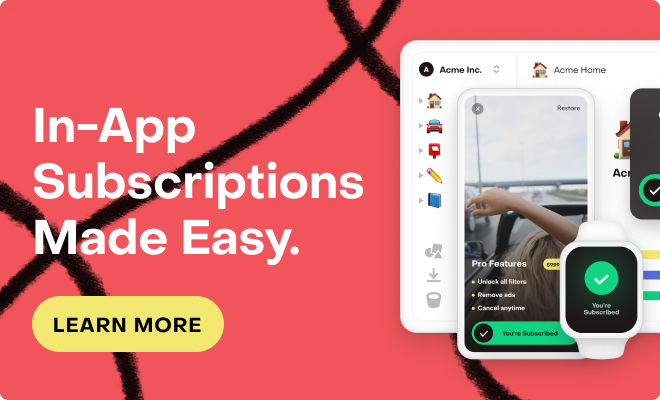Hi, if I understand the docs wel, we must do as soon as possible when the app starts do a Purchases.setup()
And then when we have our own UID (after logging into our backend) we do a Purchases.logIn(our_ID)
But when a user is logging out en back in again, another $RCAnonymousID is created and stored on the RC backend. That can add up and genereate a lot of unused $RCAnonymousID’s...or do I something wrong?
logging;
start the app for the first time.
====> APP didMount(): after Purchases.setup(), getAppUserID: $RCAnonymousID:5cf2ccddfeb64208aca7e1c8a58ab9ab
here we do in the app a login into our own backend and recieve our UID for this customer
====> RC LOGIN: before Purchases.logIn(id), getAppUserID: $RCAnonymousID:5cf2ccddfeb64208aca7e1c8a58ab9ab
====> RC LOGIN: after Purchases.logIn(id), getAppUserID: 615de0706b15db0ea9eb1555
logged in customer goes to the paywall and purchase
====> RC PAYWALL: before Purchases.getOfferings(), getAppUserID: 615de0706b15db0ea9eb1555
====> RC PAYWALL: before Purchases.purchasePackage(package), getAppUserID: 615de0706b15db0ea9eb1555
during the lifetime of the app, even after a restart of the app, the getAppUserID stays the same (must be cached on the phone)
and the entitlements are found.
====> APP didMount(): after Purchases.setup(), getAppUserID: 615de0706b15db0ea9eb1555
then i do logout inside our app (or the JWT tokens gets invalid and the customer needs to login again)
and a new $RCAnonymousID get's created.
====> RC LOGOUT: before Purchases.logOut(), getAppUserID: 615de0706b15db0ea9eb1555
====> RC LOGOUT: after Purchases.logOut(), getAppUserID: $RCAnonymousID:871a3ea51b8c4fca842ad0b976c5eecf
swipe app from memory, and restart app and AppUserID keeps same, so must again be stored at telephone
====> APP didMount(): after Purchases.setup(), getAppUserID: $RCAnonymousID:871a3ea51b8c4fca842ad0b976c5eecf
====> RC LOGIN: before Purchases.logIn(id), getAppUserID: $RCAnonymousID:871a3ea51b8c4fca842ad0b976c5eecf
====> RC LOGIN: after Purchases.logIn(id), getAppUserID: 615de0706b15db0ea9eb1555
back to the entiled user....
BUT...now there are 2 $RCAnonymousID's show up at our RC dashboard and those are groing when people are logging out of our app.
Is this normal? As designed?



